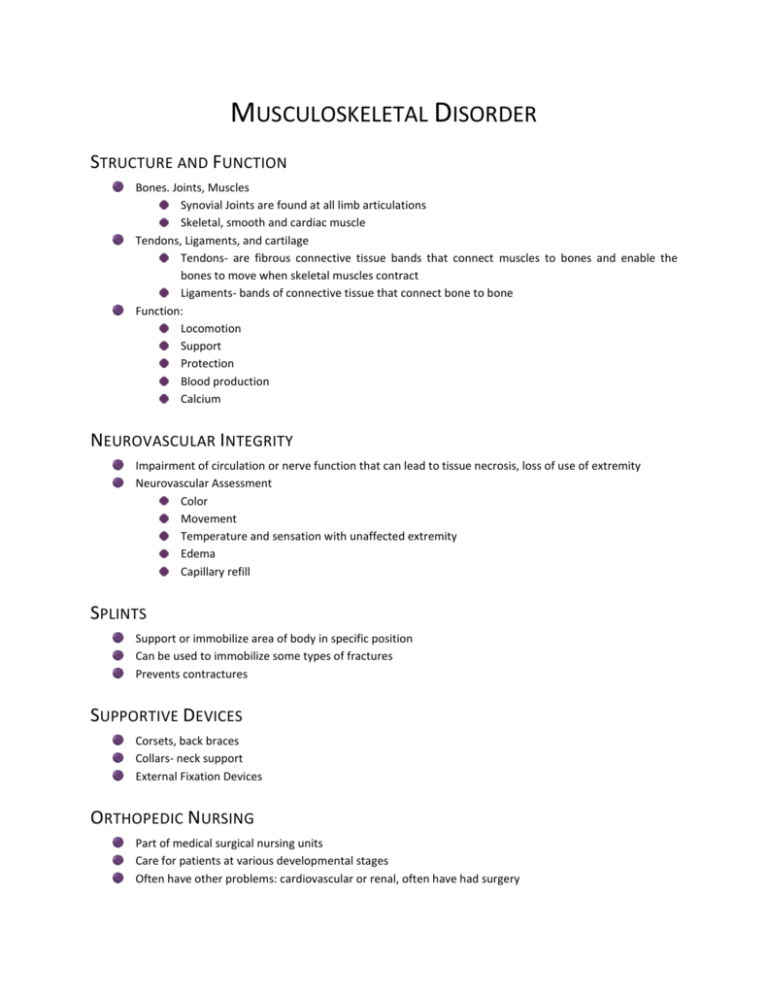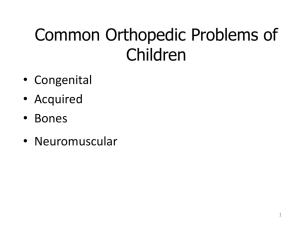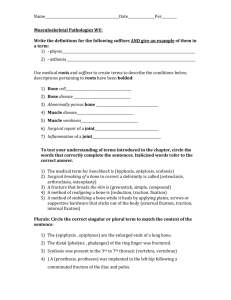Casts
advertisement

MUSCULOSKELETAL DISORDER STRUCTURE AND FUNCTION Bones. Joints, Muscles Synovial Joints are found at all limb articulations Skeletal, smooth and cardiac muscle Tendons, Ligaments, and cartilage Tendons- are fibrous connective tissue bands that connect muscles to bones and enable the bones to move when skeletal muscles contract Ligaments- bands of connective tissue that connect bone to bone Function: Locomotion Support Protection Blood production Calcium NEUROVASCULAR INTEGRITY Impairment of circulation or nerve function that can lead to tissue necrosis, loss of use of extremity Neurovascular Assessment Color Movement Temperature and sensation with unaffected extremity Edema Capillary refill SPLINTS Support or immobilize area of body in specific position Can be used to immobilize some types of fractures Prevents contractures SUPPORTIVE DEVICES Corsets, back braces Collars- neck support External Fixation Devices ORTHOPEDIC NURSING Part of medical surgical nursing units Care for patients at various developmental stages Often have other problems: cardiovascular or renal, often have had surgery CASTS Use to maintain correct alignment while healing Prevent or correct deformities Immobilizes extremity Short arm cast Long arm cast Short leg cast Long leg cast Body jacket- protects the thoracic area and lumbar spine. (compression fractures) Single hip Spica Double hip Spica- immobilizes hip and thighs (infants with congenital hip dysplasia) Plaster Fiberglass CAST CARE Plaster: Drying time- takes 24-48 hours to dry. Prevent indentations- causes pressure points underneath Rough edges- petal edges using tape Keep clean and dry Do not stick foreign objects under cast to scratch Report swelling, discoloration of toes or fingers, pain during motion, burning or tingling underneath cast. Fiberglass Faster drying time- within minutes Lighter and stronger material More expensive Do not require frequent changing Neurovascular Assessments Odor Drainage Skin Care Position/Activity- should be positioned above the heart Cast Removal- cut off with cast saw NURSING CARE FOR CASTS PG. 1026 Cast Care Support drying cast with pillows; do not cover Use the palms of the hands to handle a drying cast Frequently assess pulses, color, movement, and sensation of the affected extremity Promptly report increased or severe pain; changes in pulses, color, movement and sensation distal to the cast; or a “hot spot” or drainage on the cast Pad or tape rough cast edges t reduce skin irritation Use plastic wrap as needed to keep the cast clean and dry Client and Family Teaching The cast dries from the inside out; do not use a blow dryer to speed drying; do not cover the cast while it is drying A sensation of warmth during drying is normal Keep the cast clean and dry If a fiberglass cast gets wet, dry it with a blow dryer on cool setting Notify your doctor immediately if you develop increased pain, coolness, color changes, increased swelling, or loss of sensation to the injured limb Relive itching by blowing cool air into the cast with a blow dryer on cool setting A sling may help distribute the weight of the cast evenly around the neck; do not roll the sling because this may impair circulation Use crutches as taught to prevent weight bearing on the affected leg The cast will be removed with a cast saw. You will feel the vibration, but the saw will not cut the skin. TRACTION “Pulling”- uses a straightening or pulling force to return or maintain the fractured bones in normal position. Body acts as countertraction Rope Weights Trapeze Exercise Types of traction Skeletal traction- the pulling force is applies directly through pins inserted in the bone. It allows use of more weight to maintain bone alignments. The risk of infection is greater, however, and it may cause more discomfort Skin traction- applies the pulling force through the client’s skin. Skin traction is noninvasive and is relatively comfortable for the client. Buck’s traction- The body provides a counterweight or opposing force to the traction. The pulling force is applied to the skin of the affected leg. Bryant’s traction- abnormal formation of hips. May have spica traction. Both legs are at a 90 degree angle at the bend. Immobilizes the hip and the waist area. Nurses will set up traction according to doctor’s order to type and weight. NURSING CARE FOR TRACTION- PG 1027 Maintain the pulling force and direction Center the client on the bed; maintain body alignment with the direction of the pull. Ensure that nothing is lying on or obstructing the ropes Tape knots; do not allow knots to come in contact with the pulley Ensure that weights hang freely and do not touch the floor For skin traction: Frequently assess pulses, color, sensation, and movement distal to wrappings; notify the physician or rewrap (as ordered) if necessary. Remove weights only if intermittent traction has been ordered and to rewrap bandages Frequently assess skin, bony prominences, and pressure points for irritation or breakdown. Protect pressure sites with padding and protective dressings For skeletal traction: Never remove weights Frequently assess neurovascular status, skin, and pin insertion sites Provide pin site care as ordered (or per protocol) Report signs of infection, such as redness, drainage, and increased tenderness Report manifestations of complications of immobility, including pressure ulcers, DVT, atelectasis or pneumonia, paralytic ileus, and constipation. FOR ALL ORTHOPEDIC CLIENT Neurovascular Integrity Skin Care Issues of Immobility: gastrointestinal, genitourinary, respiratory Risk for infection Safety Psychosocial needs OSTEOMYELITIS Inflammation in bone due to infection Most common cause- repair of open fracture or open wound Other causes: Gunshot or deep puncture wounds Soft tissue infection Pressure ulcers Impaired immune function Venous stasis or arterial ulcers of the legs Diabetes mellitus Classic signs of infection present Chronic Painful Diet Increased protein and calcium Control blood sugars TRAUMATIC INJURIES Contusions- bleeding into soft tissue resulting from blunt force (bruise) Sprains- a ligament injury caused by a twisting motion that overstretches or tears the ligament Strain(sprain)- microscopic tear in the muscle that causes bleeding into the tissue (immobilization) Dislocation- bone out of joint- needs immobilization Fractures- a break in the continuity of a bone TYPES OF FRACTURES Open (compound)- Broken bone protrudes through skin Closed (simple)- skin over fracture remains intact Greenstick- incomplete break occurs along the length of the bone (children) Complete- involve the entire width of the bone Comminuted- bone fragments into many pieces Colles- wrist fracture (fall and catch on wrist) break in the distal radius Impacted- broken ends of bone are forced together Transverse- breaks straight across the width of the bone (clean break) Oblique- a break in the bone that is diagonal Spiral- jagged break occurs due to twisting force Location on bone- look at what part of bone determines the treatment for the fracture Displacement- bone breaks and does not approximate with the other piece of bone Avulsion- tissue pulls away from the bone Longitudinal- long piece breaks away from bone but does not go through entire width of the bone Interarticular- a jointed area is destroyed and the bones are hitting together Stress- common in the foot, repeated soft impact Depressed- broken bone is pressed inward (skull) SIGNS AND SYMPTOMS OF FRACTURES Depends on location Pain Swelling Tenderness Deformity Loss of function Remember that other injuries can occur simultaneously TREATMENT OF FRACTURES Reduction Closed- pull on limb to put the bone back in line Open- surgery HEALING PROCESS OF BONE Formation of new bone: Bleeding Hematoma Fibrin mesh- framework for new bone to grow Inflammatory reaction Granulation tissue- contains calcium, cartilage, and osteoblasts Callus (what the granulation tissue is called) Ossification- process by which new bone is formed COMPLICATIONS OF FRACTURES Pulmonary Embolism Thrombophlebitis Prolonged immobility Fractures to lower extremities are at a higher risk Prevention TED hose Sequential hose Get the patient moving Prophylatic Anticoagulation- Lovenox Signs and Symptoms Acute respiratory distress Substernal pain Signs of shock Treatment Oxygen therapy Ventilator Anticoagulation therapy Fat Embolism More common in young adults, multiple, crushing injuries, long bone injuries Can be fatal Prevention Cautious movement Minimum manipulation of bone fragments Immediate immobilization Signs and symptoms Mental Disturbances Respiratory distress Signs of shock within 72 hours or injury Classic appearance of petchiae on upper chest, axillae Blood Tinged sputum Treatment High concentration of O2 Control of shock, symptomatic measures to sustain life Infection Open fracture Open reduction S&S- fever, drainage, pain Compartment Syndrome- excess pressure restricts blood vessels and nerves within a compartment Increased pressure Impairs circulation Can rapidly result in permanent contracture- Volkman’s contracture Signs and Symptoms- 5 P’s Pain Pallor Paresthesia Paresis Pulselessness- ominous sign Surgical Intervention Fasciotomy HIP FRACTURE Incidence is increasing b/c living longer and over age 65 has increased risk Signs and symptoms Pain Affected extremity shortened, externally rotated Post-op hip precautions Don’t let them adduct or cross legs Hypostatic Pneumonia Urinary Calculi Pressure Ulcers Constipation Delirium or acute confusion BONE TUMORS Primary or Secondary Benign or Malignant Osteogenic sarcoma Affects long bones Occurs in children 10-15 years old If caught earlier can remove tumor and put in prosthesis Ewing’s Sarcoma Older school age children and adolescents Occurs in the marrow of the long bones Avoid weight bearing while treated to prevent pathological fractures Susceptible to radiation and chemo Metastasis from other primary tumor sites Prostate, lung, breast, thyroid, and kidney cancers most likely to metastasize AMPUTATION May be done due to: Malignant bone tumor Diabetic gangrene Other conditions that threaten patient’s life Has significant physical and psychosocial effects Post-op care Monitor for shock Monitor drainage Prevent contractures Monitor for signs/symptoms of infection Help through the grieving process Preparing for Prosthesis Prevent contractures Shape stump Temporary prosthesis Permanent Prosthesis within 3 months Physical therapy Watch for skin breakdown Phantom limb sensation Pain in amputated limb Most intense 1st 6 months May use TENS on unaffected limb to break the cycles Very real sensation PREVENTION OF CONTRACTURES AFTER AMPUTATION Encourage joint extension With above knee amputation, place in prone position several times a day; do not elevate stump on pillows after the first 24 hours For below knee amputation, elevate foot of bed, keeping knee extended Position upper extremities using the same priniciples Provide active or passive ROM exercises every 2 to 4 hours for all joints Use trapeze on bed frame to encourage frequent position changes Teach importance of moving and ROM exercises For a thigh or above knee amputation, avoid sitting for long periods Teach postural exercises to compensate for los of weight on affected side ARTHRITIS Inflammatory joint disease All types characterized by inflammatory damage to synovial membrane or articular cartilage RHEUMATOID ARTHRITIS Most serious form Autoimmune disease Chronic inflammation of connective tissue- especially joints Causes pain, joint deformity, loss of function Most common between 20-50 years Commonly effects the fingers, feet, wrists, elbows, ankles and knees May also hit the shoulders, hips, and cervical spine Because it is autoimmune, may affect the tissues in the heart, lungs, kidneys and skin Signs and symptoms Weight loss Anorexia Muscle aches Malaise Fever Swollen, painful joints- stiff in the morning Rheumatoid factor elevated Erythrocyte sedimentation rate elevated Joint damage visible on X-ray Care and Treatment Maintaining function Relieving pain Prevention deformities Rest Good body alignment NSAIDs Steroids Many need joint replacement OSTEOARTHRITIS- DEGENERATIVE JOINT DISEASE Non-inflammatory but will progress to inflammation Risk factors Joint stress Obesity Increases with age Congenital abnormalities Trauma Population affected 50% of population will have some degree of arthritis by 16 By age 65. 70% have some degree of arthritis Joints most often affected Wrists hands Neck Back Hips Knees Ankles Feet Proteoglycans- decreases in quantity and quality as we age (component of cartilage) Cartilage more susceptible to breakdown Lose cartilage, develop cysts or osteophytes (spurs, joint mice) this leads to inflammation Treatment Lose weight Exercise Analgesics Hydrocortisone injections Moist heat Surgery Post-op care for total joint replacement TEDs or SCDs Exercise Wound drainage Position to avoid dislocation ABDUCTED Knee replacement- CPM Complications Phlebitis Urinary Retention Infection Compromised circulation and/or sensation GOUTY ARTHRITIS Metabolic disease- results from accumulation of uric acid in the blood Occurs after puberty in males and after menopause in females- mostly males Usually affects great toe, but can be anywhere Primary symptoms are pain and swelling. Usually occurs at night Diagnosis by checking the uric acid level in the blood Drug therapies Colchicines- PO or IV Indocin- strong anti-inflammatory Zyloprim (allpurinol)- decreases production of uric acid Probenecid- increases excretion of uric acid Foods to avoid- high in Purine Liver Brains Kidneys Sweetbreads Sardines Scallops Mackerel Anchovies Broth/consumme Mince meat BURSITIS Inflammation of the bursae (small sacs in the shoulder, elbow, knee, hip and foot) that contain lubrication May be the result of injury, strain, or prolonged use of the joint Treatment: immobilization in sling for shoulder, analgesics, hydrocortisone injections, surgery if calcium deposits are causing the inflammation CLUB FOOT Common congenital deformity Occurs in approx. 1 of 1000 of live births Caused by improper positioning in the uterus Talipes equinovarus- foot turned with toes pointed inward Splint/cast or surgery if not corrected by the 3 years old Keep eye for neurovascular compromise and change splints as they grow rapidly






